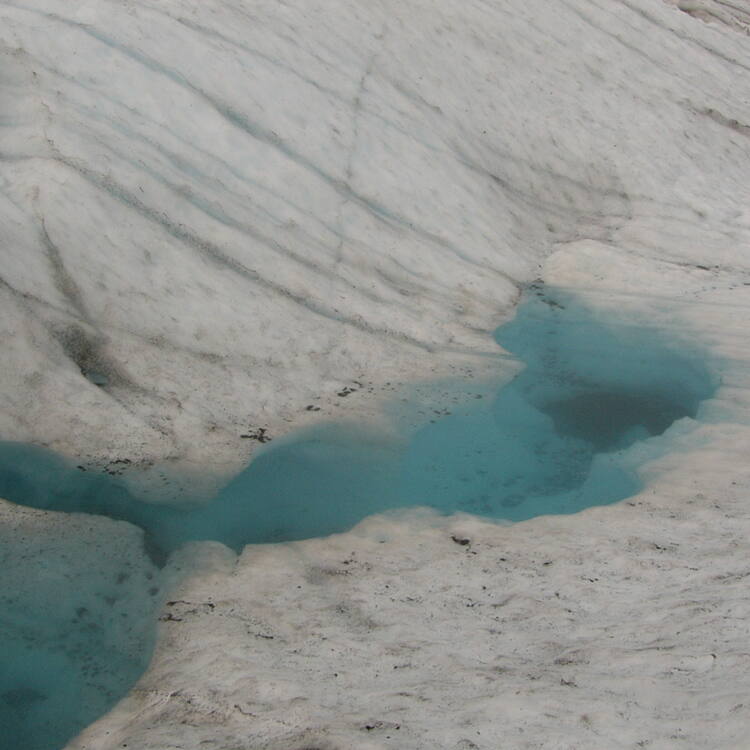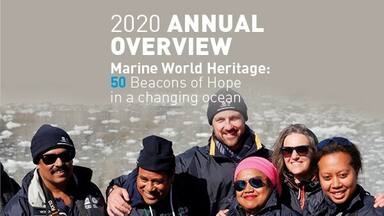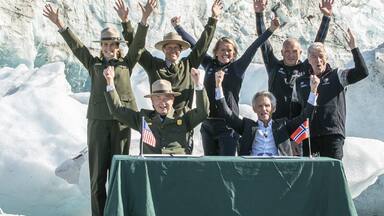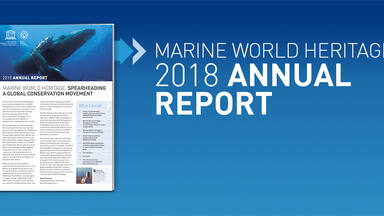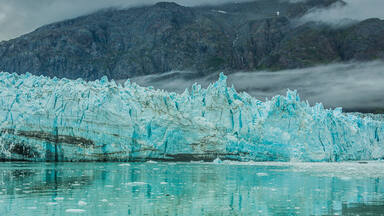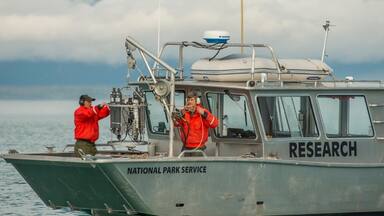Kluane / Wrangell-St. Elias / Glacier Bay / Tatshenshini-Alsek
Kluane / Wrangell-St. Elias / Glacier Bay / Tatshenshini-Alsek
These parks comprise an impressive complex of glaciers and high peaks on both sides of the border between Canada (Yukon Territory and British Columbia) and the United States (Alaska). The spectacular natural landscapes are home to many grizzly bears, caribou and Dall's sheep. The site contains the largest non-polar icefield in the world.
Description is available under license CC-BY-SA IGO 3.0
Kluane / Wrangell-St. Elias / Glacier Bay / Tatshenshini-Alsek
Cet ensemble impressionnant de glaciers et de hauts sommets, situé de part et d'autre de la frontière entre le Canada (territoire du Yukon et Colombie-Britannique) et les États-Unis d'Amérique (Alaska), constitue l'un des paysages naturels les plus spectaculaires du monde. Il abrite de nombreux grizzlis, caribous et mouflons de Dall et contient le champ de glace non polaire le plus vaste du monde.
Description is available under license CC-BY-SA IGO 3.0
كلوين/ورانغل-سانت إلياس-خليج الكتل الجليدية/تاتشانشيني ألسيك
تشكّل هذه المجموعة الرائعة من الكتل الجليدية والقمم الشاهقة التي تقع على المنطقة الحدودية بين كندا (وبالتحديد في منطقة يوكون وولاية كولومبيا البريطانية) والولايات المتحدة الأميركية (وبالتحديد ولاية ألاسكا)، منظراً من أجمل المناظر الطبيعية في العالم. وهي تأوي عدداً من الأجناس الحيوانية كدبّ الغريزلي ورنّة كندا والأغنام وتضم أكبر حقل جليدي غير قطبي في العالم.
source: UNESCO/CPE
Description is available under license CC-BY-SA IGO 3.0
克卢恩/兰格尔-圣伊莱亚斯/冰川湾/塔琴希尼-阿尔塞克
这些公园包括了位于加拿大(育空地区和英属哥伦比亚)和美国(阿拉斯加)交界处的包括冰川和高峰,景致蔚为壮观。这里是大灰熊、北美驯鹿和大角羊的栖息地,也是世界上最大的非极地冰原区。
source: UNESCO/CPE
Description is available under license CC-BY-SA IGO 3.0
Парки и резерваты Клуэйн, Врангеля-Св.Ильи, Глейшер-Бей, Татшеншини-Алсек
Эти парки и резерваты включают огромные ледники и высокие горные хребты, лежащие по обе стороны от канадско-американской границы (провинции Юкон и Британская Колумбия/штат Аляска). Выразительный природный ландшафт дает приют множеству гризли, карибу и баранов-толсторогов. Именно здесь располагаются самая большая зона оледенения вне полярных областей.
source: UNESCO/CPE
Description is available under license CC-BY-SA IGO 3.0
Kluane / Wrangell-St. Elias / Bahía de los Glaciares / Tatshenshini-Alsek
Este impresionante conjunto de glaciares y picos elevados está situado a ambos lados de la frontera entre el Canadá (Territorio del Yukón y Columbia Británica) y los Estados Unidos de América (Alaska). Sus espectaculares paisajes naturales son refugio de numerosos osos grizzli, caribúes y muflones de Dall. El sitio cuenta además con el campo de hielo más vasto del mundo situado fuera de la zona polar.
source: UNESCO/CPE
Description is available under license CC-BY-SA IGO 3.0
クルアーニー/ランゲル-セント・イライアス/グレーシャー・ベイ/タッチェンシニー-アルセク
アラスカ南東部からカナダ北西部の広がるこの一帯は、世界最大規模の自然保護区で、氷河期からの自然美がそのままに残されている。第2次世界大戦中のアラスカの軍事拠点化、戦後の油田発見などがあったが、1960年代からはこの比類無い自然景観の価値が認められるようになった。数多くの高峰、無数の氷河。U字谷、ツンドラ地帯の森林や平原などが人々を魅了している。source: NFUAJ
Nationale parken Kluane, Wrangell-St. Elias, Glacier Bay en Tatshenshini-Alsek
Deze parken bestaan uit een indrukwekkend geheel van gletsjers en hoge bergen aan beide zijden van de grens tussen Canada (Yukon Territory en British Columbia) en de Verenigde Staten (Alaska). Er leven veel verschillende soorten planten en dieren. De adembenemende natuurlandschappen zijn de thuisbasis voor vele grizzlyberen, kariboes en Dall-schapen. Het hele terrein is een tektonisch actief en spectaculair gebied, waar natuurlijke processen de overhand hebben. Zo bevatten de parken prachtige voorbeelden van ijsvorming en verandering in het landschap door toedoen van glaciale werking. De plek bevat onder andere het grootste niet-polaire ijsveld ter wereld.
Source: unesco.nl
Outstanding Universal Value
Brief synthesis
The Kluane / Wrangell-St. Elias / Glacier Bay / Tatshenshini-Alsek national parks and protected areas along the boundary of Canada and the United States of America contain the largest non-polar icefield in the world as well as examples of some of the world’s longest and most spectacular glaciers. Characterized by high mountains, icefields and glaciers, the property transitions from northern interior to coastal biogeoclimatic zones, resulting in high biodiversity with plant and animal communities ranging from marine, coastal forest, montane, sub-alpine and alpine tundra, all in various successional stages. The Tatshenshini and Alsek river valleys are pivotal because they allow ice-free linkages from coast to interior for plant and animal migration. The parks demonstrate some of the best examples of glaciation and modification of landscape by glacial action in a region still tectonically active, spectacularly beautiful, and where natural processes prevail.
Criterion (vii): The joint properties encompass the breadth of active tectonic, volcanic, glacial and fluvial natural processes from the ocean to some of the highest peaks in North America. Coastal and marine environments, snow-capped mountains, calving glaciers, deep river canyons, fjord-like inlets and abundant wildlife abound. It is an area of exceptional natural beauty.
Criterion (viii): These tectonically active joint properties feature continuous mountain building and contain outstanding examples of major ongoing geologic and glacial processes. Over 200 glaciers in the ice-covered central plateau combine to form some of the world’s largest and longest glaciers, several of which stretch to the sea. The site displays a broad range of glacial processes, including world-class depositional features and classic examples of moraines, hanging valleys, and other geomorphological features.
Criterion (ix): The influence of glaciation at a landscape level has led to a similarly broad range of stages in ecological succession related to the dynamic movements of glaciers. Subtly different glacial environments and landforms have been concentrated within the property by the sharp temperature and precipitation variation between the coast and interior basins. There is a rich variety of terrestrial and coastal/marine environments with complex and intricate mosaics of life at various successional stages from 500 m below sea level to 5000 m above.
Criterion (x): Wildlife species common to Alaska and Northwestern Canada are well represented, some in numbers exceeded nowhere else. The marine components support a great variety of fauna including marine mammals and anadromous fish, the spawning of which is a key ecological component linking the sea to the land through the large river systems. Populations of bears, wolves, caribou, salmon, Dall sheep and mountain goats that are endangered elsewhere are self-regulating here. This is one of the few places remaining in the world where ecological processes are governed by natural stresses and the evolutionary changes in a glacial and ecological continuum.
Integrity
At 9,839,121 ha, including 242,700 ha of marine waters and 1,900 km of coastline, the property is vast and encompasses all the elements required to express its exceptional beauty and scientific values. The boundaries connect key land masses within which a wide breadth of glacial, ecological and biological processes are exhibited. Geomorphological processes are shown in the various successive stages of altitude within the property. Healthy terrestrial and marine fish and wildlife populations of key species endemic to the northwest of the North American continent are well-represented within the property, ecological processes are functioning naturally within intact ecosystems, and the property as a whole retains its wilderness values and character, and its scenic beauty.
Park management plans have identified a number of resource protection measures, such as environmental assessment processes, zoning, ecological integrity and visitor experience monitoring, and education programs to address internal and external pressures from recreational use, commercial growth and development adjacent to the property. These measures allow the property managers to monitor and respond to any long term challenges in order to protect the property’s integrity into the future. Sport or subsistence harvest of fish and wildlife, including commercial trapping, are closely monitored and managed sustainably in areas where these activities are allowed.
Protection and management requirements
The property consists of four components that are protected and managed under specific legislative frameworks within Canada and the United States of America. Kluane National Park and Reserve is managed under the authority of the Canada National Parks Act and its associated regulations which govern the protection and management of the natural and cultural resources of the park. Land Claim Final Agreements with the Champagne and Aishihik and Kluane First Nations provide additional direction for the protection and management of the park’s natural and cultural resources. These agreements have also established the Kluane National Park Management Board, a co-operative management regime for managing park resources.
Wrangell-St. Elias and Glacier Bay National Park and Preserves are administered under the authority of the Organic Act of August 25, 1916 which established the United States National Park Service, as well as specific enabling legislation for each park and other laws and regulations pertaining to the National Park Service. Day-to-day management is directed by a Park Superintendent and these parks are managed in accordance with the legislative and regulatory mandates of the U.S. National Park Service. Wrangell-St. Elias National Park and Preserve has formal government-to-government agreements with three federally recognized tribal governments: the Cheesh'na Tribal Council, the Mentasta Traditional Council, and the Yakutat Tlingit Tribe. The Yakutat Tlingit Tribe agreement involves both Wrangell-St. Elias and Glacier Bay National Parks. Glacier Bay National Park also has a government-to-government relationship with the Huna Tlingit Tribe.
Tatshenshini-Alsek Park was established by the Province of British Columbia as a Class A park by an enactment of the provincial legislature and is managed under the Parks Act and the Protected Areas of British Columbia Act and associated regulations. In 1996, the Champagne-Aishihik First Nations (CAFN) and the Government of British Columbia signed the bi-lateral Tatshenshini-Alsek Park Management Agreement, which, in part, directed CAFN and British Columbia Parks to jointly manage Tatshenshini-Alsek Park.
Management goals and objectives for the property have been developed through management plans for each individual protected area, specifically: the Kluane National Park and Reserve Management Plan (2010); the Wrangell-St. Elias National Park and Preserve General Management Plan (1986); the Glacier Bay National Park and Preserve General Management Plan (1984); and the Management Direction Statement (2000) for Tatshenshini-Alsek Park. Although management of each component of the property is directed by an individual management plan, there are a number of guiding principles related to natural and cultural resource management, visitor use and interpretation, science and research and relations with Aboriginal peoples that are common to all of the plans, reflecting strong cooperation among the property managers. The management plans and their associated goals and objectives are periodically reviewed and updated with First Nation, Native Alaskan, public, stakeholder and partner input, direction and advice.
Special attention will be given over the long term to monitoring and taking appropriate actions related to a number of factors in and near the property. Specifically, attention will focus on monitoring aquatic resources and forest and tundra ecosystem health. Park authorities manage or monitor human use, including visitation; infrastructure development; solid waste management; impacts of climate change; wildlife populations; biological and physical resource use; ecological disturbances such as fire; impacts from sudden geological events; and the potential for invasive or hyper-abundant species.
Notes
-
Extension of the "Glacier Bay/Wrangell/St Elias/Kluane" property.
- Property inscribed for both geological and ecological values under natural criterion N (ii) before 1994. Criterion N (i) [Operational Guidelines 2002] was added. For more details see Decision 30.COM 8D.1.
